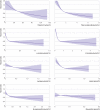Association of plasma biomarkers of fruit and vegetable intake with incident type 2 diabetes: EPIC-InterAct case-cohort study in eight European countries
- PMID: 32641421
- PMCID: PMC7341350
- DOI: 10.1136/bmj.m2194
Association of plasma biomarkers of fruit and vegetable intake with incident type 2 diabetes: EPIC-InterAct case-cohort study in eight European countries
Abstract
Objective: To investigate the association of plasma vitamin C and carotenoids, as indicators of fruit and vegetable intake, with the risk of type 2 diabetes.
Design: Prospective case-cohort study.
Setting: Populations from eight European countries.
Participants: 9754 participants with incident type 2 diabetes, and a subcohort of 13 662 individuals from the European Prospective Investigation into Cancer and Nutrition (EPIC) cohort of 340 234 participants: EPIC-InterAct case-cohort study.
Main outcome measure: Incident type 2 diabetes.
Results: In a multivariable adjusted model, higher plasma vitamin C was associated with a lower risk of developing type 2 diabetes (hazard ratio per standard deviation 0.82, 95% confidence interval 0.76 to 0.89). A similar inverse association was shown for total carotenoids (hazard ratio per standard deviation 0.75, 0.68 to 0.82). A composite biomarker score (split into five equal groups), comprising vitamin C and individual carotenoids, was inversely associated with type 2 diabetes with hazard ratios 0.77, 0.66, 0.59, and 0.50 for groups 2-5 compared with group 1 (the lowest group). Self-reported median fruit and vegetable intake was 274 g/day, 396 g/day, and 508 g/day for participants in categories defined by groups 1, 3, and 5 of the composite biomarker score, respectively. One standard deviation difference in the composite biomarker score, equivalent to a 66 (95% confidence interval 61 to 71) g/day difference in total fruit and vegetable intake, was associated with a hazard ratio of 0.75 (0.67 to 0.83). This would be equivalent to an absolute risk reduction of 0.95 per 1000 person years of follow up if achieved across an entire population with the characteristics of the eight European countries included in this analysis.
Conclusions: These findings indicate an inverse association between plasma vitamin C, carotenoids, and their composite biomarker score, and incident type 2 diabetes in different European countries. These biomarkers are objective indicators of fruit and vegetable consumption, and suggest that diets rich in even modestly higher fruit and vegetable consumption could help to prevent development of type 2 diabetes.
© Author(s) (or their employer(s)) 2019. Re-use permitted under CC BY. No commercial re-use. See rights and permissions. Published by BMJ.
Conflict of interest statement
Competing interests: All authors have completed the ICMJE uniform disclosure form at www.icmje.org/coi_disclosure.pdf and declare: support from European commission, UK Medical Research Council, British Heart Foundation, and National Institute for Health Research Cambridge Biomedical Research Centre for the submitted work; no financial relationships with any organisations that might have an interest in the submitted work in the previous three years; no other relationships or activities that could appear to have influenced the submitted work. Where authors are identified as personnel of the International Agency for Research on Cancer/World Health Organization, the authors alone are responsible for the views expressed in this article and they do not necessarily represent the decisions, policy, or views of the International Agency for Research on Cancer/WHO.
Figures



Comment in
-
Dietary factors in the risk of T2DM.Nat Rev Endocrinol. 2020 Oct;16(10):537. doi: 10.1038/s41574-020-0401-5. Nat Rev Endocrinol. 2020. PMID: 32724182 No abstract available.
-
"5 am Tag" schützt auch vor Diabetes.MMW Fortschr Med. 2020 Nov;162(Suppl 3):30. doi: 10.1007/s15006-020-4562-x. MMW Fortschr Med. 2020. PMID: 33164183 Review. German. No abstract available.
